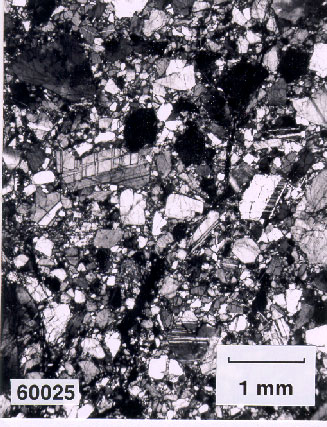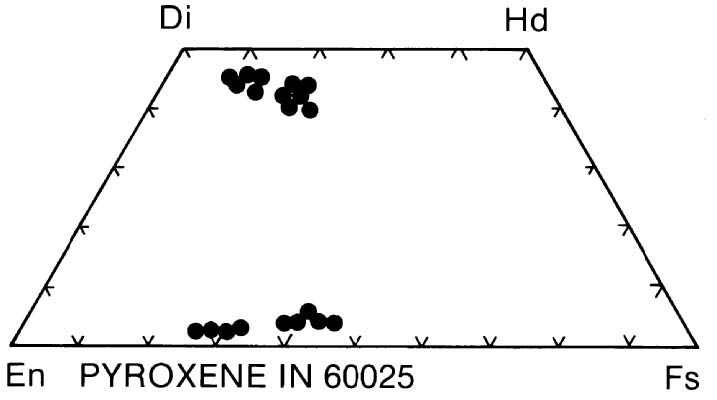
BRIEF DESCRIPTION OF 60025
| Lunar Sample Compendium Link | Lunar Sample Catalog Link | Open University Virtual Microscope Link |
Figure 40. Cross-polarized-light photo of cataclastic anorthosite 60025. Note the “kink banding” of the polysynthetic twinning in the shocked plagioclase.
Lunar sample 60025 is a cataclastic anorthosite from Apollo 16. In detail, this sample is found to be a densely lithified mixture of pieces of plagioclase-rich rock from a related sequence of lunar anorthosites (Ryder 1982). It is 98 percent plagioclase and only about 2 percent pyroxene (fig. 40). Small “clumps” of mafic minerals are in the hand specimen, but these are not represented in the thin sections. The composition of this rock is given in table 6. The age of this rock is 4440 million years.
Olivine - Trace olivine Fo65-67 is found with low-Ca pyroxene in “mafic clumps.”
Pyroxene - Small subhedral grains of augite and orthopyroxene are found in the fine-grained matrix. Some pigeonite grains are exsolved. The pyroxenes exhibit a wide miscibility gap on the pyroxene quadrilateral (fig. 41) indicative of equilibration at relatively low temperature. There is a rather wide range of pyroxene composition En5O-75.
Figure 41. Composition of pyroxene in cataclastic anorthosite 60025. This is a rather wide range for pyroxene in a plutonic rock and indicates that sample 60025 has formed from a series of related anorthosites.
Plagioclase - Large plagioclase crystals have been fractured and crushed. Some of the crystals show polysynthetic twinning. Twin lamellae are often bent or offset by fractures and/or strain induced by shock. The plagioclase in this rock is An95-97.
Opaques - Minute crystals of ilmenite, metallic Fe, and troilite have been found as inclusions within plagioclase. Chromite has been reported in the “mafic clumps”.
Petrogenesis - The monomineralic nature of this rock requires a cumulate origin. Actually, the range in pyroxene composition requires that it be a mechanical mixture of a series of related anorthosites (Ryder 1982). The relatively Fe-rich nature of trace mafic minerals is typical of lunar anorthosites and has led to the term ferroan anorthosite.


